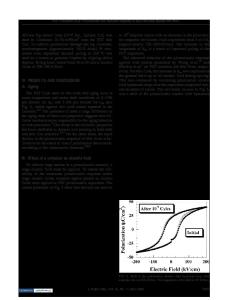Piezoelectric polymer thin films with architected cuts
- PDF / 910,482 Bytes
- 13 Pages / 584.957 x 782.986 pts Page_size
- 92 Downloads / 373 Views
Jing Li Department of Mechanical Engineering, Johns Hopkins University, Baltimore, Maryland 21218, USA; Hopkins Extreme Materials Institute, Johns Hopkins University, Baltimore, Maryland 21218, USA; and Hubei Key Laboratory of Advanced Technology for Automotive Components, Wuhan University of Technology, Wuhan, Hubei 430070, China
Zeyu Zhu, Santiago Orrego, and Sung Hoon Kanga) Department of Mechanical Engineering, Johns Hopkins University, Baltimore, Maryland 21218, USA; and Hopkins Extreme Materials Institute, Johns Hopkins University, Baltimore, Maryland 21218, USA (Received 29 September 2017; accepted 2 January 2018)
Introducing architected cuts is an attractive and simple approach to tune mechanical behaviors of planar materials like thin films for desirable or enhanced mechanical performance. However, little has been studied on the effects of architected cuts on functional materials like piezoelectric materials. We investigated how architected cut patterns affect mechanical and piezoelectric properties of polyvinylidene fluoride thin films by numerical, experimental, and analytical studies. Our results show that thin films with architected cuts can provide desired mechanical features like enhanced compliance, stretchability, and controllable Poisson’s ratio and resonance frequency, while maintaining piezoelectric performance under static loadings. Moreover, we could observe maximum ;30% improvement in piezoelectric conversion efficiency under dynamic loadings and harvest energy from low frequency (,100 Hz) mechanical signals or low velocity (,5 m/s) winds, which are commonly existing in ambient environment. Using architected cuts doesn’t require changing the material or overall dimensions, making it attractive for applications in self-powered devices with design constraints.
I. INTRODUCTION
In the past decades, there have been remarkable advances in designing, modeling, and fabricating architected materials,1–11 which could achieve novel mechanical properties/ behaviors by the interplay between materials and specially designed geometries.12 In particular, due to readily available tools for shaping a diverse set of materials across different length scales, there have been many studies that investigated various planar periodic structures to introduce novel mechanical behaviors typically unavailable in bulk materials, including negative Poisson’s ratio (auxetic),13–17 stretchability,18 trapping elastic energy,19,20 negative effective swelling coefficient,21 and controlling propagation of mechanical signals.22–24 Among various approaches for making architected materials, introducing cuts (“kirigami”) instead of large voids is a popular and straightforward approach to add architecture to thin films18 and an attractive way to manipulate the properties of resulting architected materials with minimum effects on mechanical integrity compared to materials with large pores.23 There Contributing Editor: Christopher Spadaccini a) Address all correspondence to this author. e-mail: [email protected] DOI: 10.1557/jmr.2018.6
have be
Data Loading...











